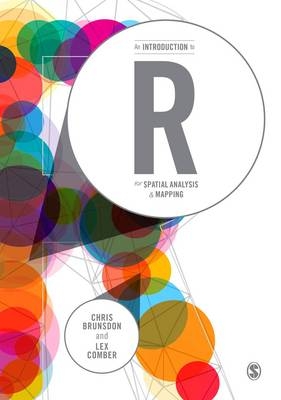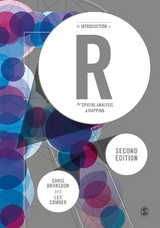
An Introduction to R for Spatial Analysis and Mapping
SAGE Publications Ltd (Verlag)
9781446272947 (ISBN)
- Titel erscheint in neuer Auflage
- Artikel merken
"In an age of big data, data journalism and with a wealth of quantitative information around us, it is not enough for students to be taught only 100 year old statistical methods using ′out of the box′ software. They need to have 21st-century analytical skills too. This is an excellent and student-friendly text from two of the world leaders in the teaching and development of spatial analysis. It shows clearly why the open source software R is not just an alternative to commercial GIS, it may actually be the better choice for mapping, analysis and for replicable research. Providing practical tips as well as fully working code, this is a practical ′how to′ guide ideal for undergraduates as well as those using R for the first time. It will be required reading on my own courses."
- Richard Harris, Professor of Quantitative Social Science, University of Brist#strong
/strong#
R is a powerful open source computing tool that supports geographical analysis and mapping for the many geography and ‘non-geography’ students and researchers interested in spatial analysis and mapping.
This book provides an introduction to the use of R for spatial statistical analysis, geocomputation and the analysis of geographical information for researchers collecting and using data with location attached, largely through increased GPS functionality.
Brunsdon and Comber take readers from ‘zero to hero’ in spatial analysis and mapping through functions they have developed and compiled into R packages. This enables practical R applications in GIS, spatial analyses, spatial statistics, mapping, and web-scraping. Each chapter includes:
Example data and commands for exploring it
Scripts and coding to exemplify specific functionality
Advice for developing greater understanding - through functions such as locator(), View(), and alternative coding to achieve the same ends
Self-contained exercises for students to work through
Embedded code within the descriptive text.
This is a definitive ′how to′ that takes students - of any discipline - from coding to actual applications and uses of R.
Chris Brunsdon is Professor of Geocomputation and Director of the National Centre for Geocomputation at the National University of Ireland, Maynooth, having worked previously in the Universities of Newcastle, Glamorgan, Leicester and Liverpool, variously in departments focusing on both geography and computing. He has interests that span both of these disciplines, including spatial statistics, geographical information science, and exploratory spatial data analysis, and in particular the application of these ideas to crime pattern analysis, the modelling of house prices, medical and health geography and the analysis of land use data. He was one of the originators of the technique of geographically weighted regression (GWR). He has extensive experience of programming in R, going back to the late 1990s, and has developed a number of R packages which are currently available on CRAN, the Comprehensive R Archive Network. He is an advocate of free and open source software, and in particular the use of reproducible research methods, and has contributed to a large number of workshops on the use of R and of GWR in a number of countries, including the UK, Ireland, Japan, Canada, the USA, the Czech Republic and Australia. When not involved in academic work he enjoys running, collecting clocks and watches, and cooking – the last of these probably cancelling out the benefits of the first. Alexis Comber, Lex, is Professor of Spatial Data Analytics at Leeds Institute for Data Analytics (LIDA) the University of Leeds. He worked previously at the University of Leicester where he held a chair in Geographical Information Science. His first degree was in Plant and Crop Science at the University of Nottingham and he completed a PhD in Computer Science at the Macaulay Institute, Aberdeen (now the James Hutton Institute) and the University of Aberdeen. This developed expert systems for land cover monitoring from satellite imagery and brought him into the world of spatial data, spatial analysis, and mapping. Lex’s research interests span many different application areas including environment, land cover / land use, demographics, public health, agriculture, bio-energy and accessibility, all of which require multi-disciplinary approaches. His research draws from methods in geocomputation, mathematics, statistics and computer science and he has extended techniques in operations research / location-allocation (what to put where), graph theory (cluster detection in networks), heuristic searches (how to move intelligently through highly dimensional big data), remote sensing (novel approaches for classification), handling divergent data semantics (uncertainty handling, ontologies, text mining) and spatial statistics (quantifying spatial and temporal process heterogeneity). He has co-authored (with Chris Brunsdon) An Introduction to R for Spatial Analysis and Mapping, the first ‘how to book’ for spatial analyses and mapping in R, the open source statistical software, now in its second edition. Outside of academic work and in no particular order, Lex enjoys his vegetable garden, walking the dog and playing pinball (he is the proud owner of a 1981 Bally Eight Ball Deluxe).
Part 1: Introduction
Objectives of this book
Spatial Data Analysis in R
Chapters and Learning Arcs
The R Project for Statistical Computing
Obtaining and Running the R software
The R interface
Other resources and accompanying website
Part 2: Data and Plots
The basic ingredients of R: variables and assignment
Data types and Data classes
Plots
Reading, writing, loading and saving data
Part 3: Handling Spatial Data in R
Introduction: GISTools
Mapping spatial objects
Mapping spatial data attributes
Simple descriptive statistical analyses
Part 4: Programming in R
Building blocks for Programs
Writing Functions
Writing Functions for Spatial Data
Part 5: Using R as a GIS
Spatial Intersection or Clip Operations
Buffers
Merging spatial features
Point-in-polygon and Area calculations
Creating distance attributes
Combining spatial datasets and their attributes
Converting between Raster and Vector
Introduction to Raster Analysis
Part 6: Point Pattern Analysis using R
What is Special about Spatial?
Techniques for Point Patterns Using R
Further Uses of Kernal Density Estimation
Second Order Analysis of Point Patterns
Looking at Marked Point Patterns
Interpolation of Point Patterns With Continuous Attributes
The Kringing approach
Part 7: Spatial Attribute Analysis With R
The Pennsylvania Lung Cancer Data
A Visual Exploration of Autocorrelation
Moran′s I: An Index of Autocorrelation
Spatial Autoregression
Calibrating Spatial Regression Models in R
Part 8: Localised Spatial Analysis
Setting Up The Data Used in This Chapter
Local Indicators of Spatial Association
Self Test Question
Further Issues with the Above Analysis
The Normality Assumption and Local Moran′s-I
Getis and Ord′s G-statistic
Geographically Weighted Approaches
Part 9: R and Internet Data
Direct Access to Data
Using RCurl
Working with APIs
Using Specific Packages
Web Scraping
Epilogue
| Erscheint lt. Verlag | 3.2.2015 |
|---|---|
| Verlagsort | London |
| Sprache | englisch |
| Maße | 170 x 242 mm |
| Gewicht | 760 g |
| Themenwelt | Mathematik / Informatik ► Mathematik |
| Sozialwissenschaften ► Soziologie ► Empirische Sozialforschung | |
| ISBN-13 | 9781446272947 / 9781446272947 |
| Zustand | Neuware |
| Informationen gemäß Produktsicherheitsverordnung (GPSR) | |
| Haben Sie eine Frage zum Produkt? |
aus dem Bereich



